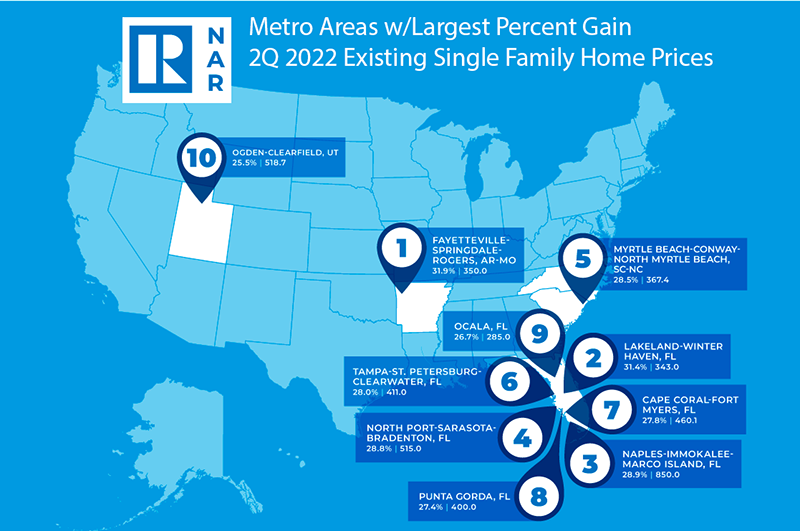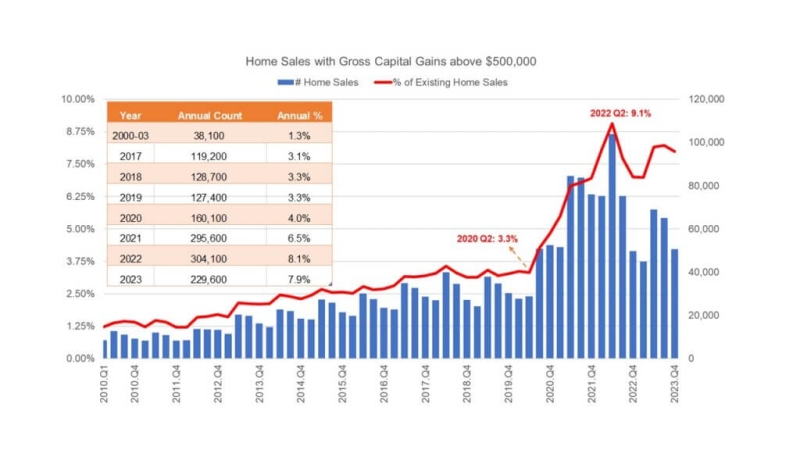
Home Prices In Q2 Rose By Double-Digits In 4 In 5 Metro Areas

NAR report says housing affordability tumbled dramatically in the second quarter.
- Eighty percent of metro markets – 148 of 185 – saw double-digit annual price appreciation in median single-family existing-home sales prices (70% in Q1).
- The national median single-family existing-home price rose 14.2% annually to $413,500, surpassing $400,000 for the first time.
- Housing affordability significantly declined as the monthly mortgage payment on a typical existing single-family home with a 20% down payment skyrocketed by nearly a third from the first quarter of this year and by half from one year ago.
Despite climbing mortgage rates and falling home sales in the second quarter of 2022, a greater number of metropolitan markets experienced double-digit annual home-price gains from the first quarter, the National Association of Realtors (NAR) said today.
Housing affordability, meanwhile, tumbled dramatically in the quarter, the NAR said.
According to the NAR report, 80%, or 148, of the 185 tracked metro areas posted double-digit price gains, up from 70% in the previous quarter.
Nationwide, the median single-family existing-home price topped $400,000 for the first time, rising 14.2% from a year ago to $413,500. Year-over-year price appreciation eased slightly compared to the previous quarter’s 15.4%, the NAR said.
“Home prices have increased at a pace that far exceeds wage gains, especially for low- and middle-income workers,” NAR Chief Economist Lawrence Yun said. “Overall, the national price deceleration inevitably followed the softening sales, providing well-positioned prospective buyers a small measure of welcomed relief.”
He added that “recent dips in mortgage rates will bring additional buyers to market, especially in those places where home prices are still relatively affordable and where jobs are being added.”
By Region
Regionally, the South accounted for 44% of single-family existing-home sales in the second quarter and posted the largest price appreciation at 18.2%. Prices increased 12.7% in the West, 10.1% in the Northeast, and 9.7% in the Midwest, the NAR said.
The top 10 metro areas with the largest year-over-year price gains all recorded increases greater than 25%, with seven of those markets located in Florida. They include:
- Fayetteville-Springdale-Rogers, Ark.-Mo. (31.9%);
- Lakeland-Winter Haven, Fla. (31.4%);
- Naples-Immokalee-Marco Island, Fla. (28.9%);
- North Port-Sarasota-Bradenton, Fla. (28.8%);
- Myrtle Beach-Conway-North Myrtle Beach, S.C.-N.C. (28.5%);
- Tampa-St. Petersburg-Clearwater, Fla. (28.0%);
- Cape Coral-Fort Myers, Fla. (27.8%);
- Punta Gorda, Fla. (27.4%);
- Ocala, Fla. (26.7%); and
- Ogden-Clearfield, Utah (25.5%).
The top 10 most expensive markets in the U.S., half of which were in California, included:
- San Jose-Sunnyvale-Santa Clara, Calif. ($1,900,000; 11.8%); \
- San Francisco-Oakland-Hayward, Calif. ($1,550,000; 11.9%);
- Anaheim-Santa Ana-Irvine, Calif. ($1,300,000; 17.2%);
- Urban Honolulu, Hawaii ($1,145,000; 17.3%);
- San Diego-Carlsbad, Calif. ($965,900; 13.6%);
- Boulder, Colo. ($933,400; 11.8%);
- Naples-Immokalee-Marco Island, Fla. ($850,000; 28.9%);
- Los Angeles-Long Beach-Glendale, Calif. ($825,700; 9.2%);
- Seattle-Tacoma-Bellevue, Wash. ($818,900; 14.4%); and
- Boston-Cambridge-Newton, Mass.-N.H. ($722,200; 8.9%).
“The local job market performance and supply availability are the clear distinguishing factors driving local home price growth,” Yun said. “Job growth is positive and should be applauded, but supply restraints are creating unnecessary barriers to ownership opportunities.”
Affordability tumbles
Housing affordability tumbled dramatically in the second quarter of 2022, driven by sharply rising mortgage rates and climbing home prices. The monthly mortgage payment on a typical existing single-family home with a 20% down payment jumped to $1,841. That’s an increase of $444, or 32%, from the first quarter of this year and $612, or 50%, from one year ago.
Families typically spent 24.3% of their income on mortgage payments, up from 18.7% the prior quarter and 16.9% one year ago.
Growing unaffordability affected first-time buyers looking to buy a typical home during the second quarter, NAR said. For a typical starter home valued at $351,500 with a 10% down-payment loan, the mortgage payment rose to $1,810, an increase of $433, or 31%, from the first quarter and $597, or 49%, from a year earlier.
First-time buyers typically spent 36.8% of their family income on mortgage payments, up from 28.7% in the previous quarter, NAR said. A mortgage is considered unaffordable if the monthly payment (principal and interest) amounts to over 25% of the family’s income.
A family needed at least $100,000 to afford a 10% down-payment mortgage in 53 markets, nearly double the 27 markets from the first quarter. Yet, a family needed less than $50,000 to afford a home in 23 markets, down significantly from 63 markets in the previous quarter, NAR said.
The National Association of Realtors is America’s largest trade association, representing more than 1.5 million members involved in all aspects of the residential and commercial real estate industries.




